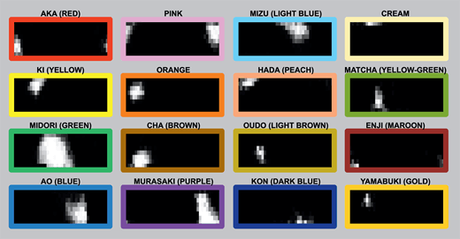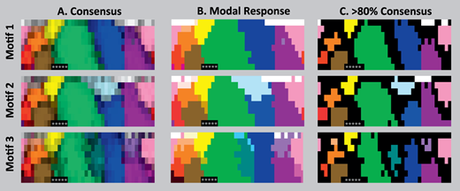One nuance of language that I hadn’t considered before spending a year in Japan is how words for expressing categories sometimes don’t quite line up. For example, in Japanese ‘juusu’ or juice refers not just to fruit and vegetable juices, but also soft-drinks. But what’s more, the line between fruits and vegetables itself is different, and, yes, melons are considered vegetables in Japanese.
To listen to a discussion about this, skip to minute 23:40.
In English the line is blurry (is a tomato a fruit)? And there are different definitions used commonly in ordinary language, by botanists, and even the supreme court. And while we’re here, is corn a vegetable or a grain? You can imagine that it must be quite confusing to learn the borders between these words. Somehow these objects and concepts are sorted and clustered based on various characteristics: are they sweet, are they seed-bearing, how closely do they resemble some prototypical fruit…
Colors in American English and Japanese
But, what is considered a cluster, and where the lines are drawn varies from language to language. Another classic example of this is colors. Colors lie on a spectrum of infinite minute variations, but linguistically we chop them up: yellow, green, blue, purple. But exactly where these lines are drawn, and how many basic categories there are varies between languages. For example, midori or green is a relatively late linguistic addition to Japanese and to this day fresh vegetables and traffic lights are describe as aoi which now means blue, but used to–and in these contexts, it still does–describe a set of clusters that encompassed both blue and green.

Clusters of ‘chromatic color categories in color space’ Kuriki et al., 2017
And while it’s easy to say, ‘wow, that’s so strange,’ are you bothered by the fact that we don’t really have a commonly used word for sky blue/light blue/cyan ? According to Kuriki et al., 2017, this color is now often described using the word ‘mizu’ (full text article) which literally means water. And here, I’d like to switch gears and dig into this study.
Furthermore, an Aoi-like category existed in Old English:
In an interesting parallel to the development of Japanese, Old English had both a term for grue (hœwen) and a term for green (grene; reviewed by Biggam, 1997). Hœwen meant green, blue, gray, and possibly purple (Clark Hall, 1916, pg. 144) among the common people, but it was restricted to blue among the educated elite. Bleu moved from Norman French into Middle English in the 13th century, replacing hœwen and meaning only blue, whereas the meaning of grene changed little. In modern English, blue and green are distinct color terms. It is important to recognize, however, that Japanese and English lexical divisions of blues and greens have been changing more recently in different ways. For example, the basic Japanese color term mizu (light blue) has no common equivalent in American English (L&B), whereas Japanese lacks a term that is equivalent to teal, a common American English color category that straddles the boundary between blue and green.
Kuriki et al’s study also shows these boundaries are continuing to change over time, and I can’t help but wonder how much of this is due to the names chosen by crayon companies :-).
The study goes on to compare these results with those of a recent study of Americans, and finds there are some colors we have a lot of agreement on: aka/red, ki/yellow, midori/green, ao/blue, pink/pink, orange/orange, cha/brown, murasaki/purple, shiro/white. But that some Japanese add mizu, and some Americans used the terms teal and lavendar to further distinguish between colors.

Motif 1 = Agreement between Japanese and English respondents, Motif 2 = uniquely Japanese with the added mizu cluster, Motif 3 = uniquely american that includes teal, lavender and also missing a cluster for white
Finally, this study also demonstrates that there is huge individual variation between people, even people speaking the same language. Somewhere in our brain we’re creating concepts, clusters, classifications, that separate between colors, and where we draw the lines or even the words that are part of our lexicon can be quite different. (Like, is the word lexicon in your lexicon? :-p)
When it comes to color though, a picture is truly worth a thousands words, and a hexadecimal code is probably worth 4,096.
Advertisements
